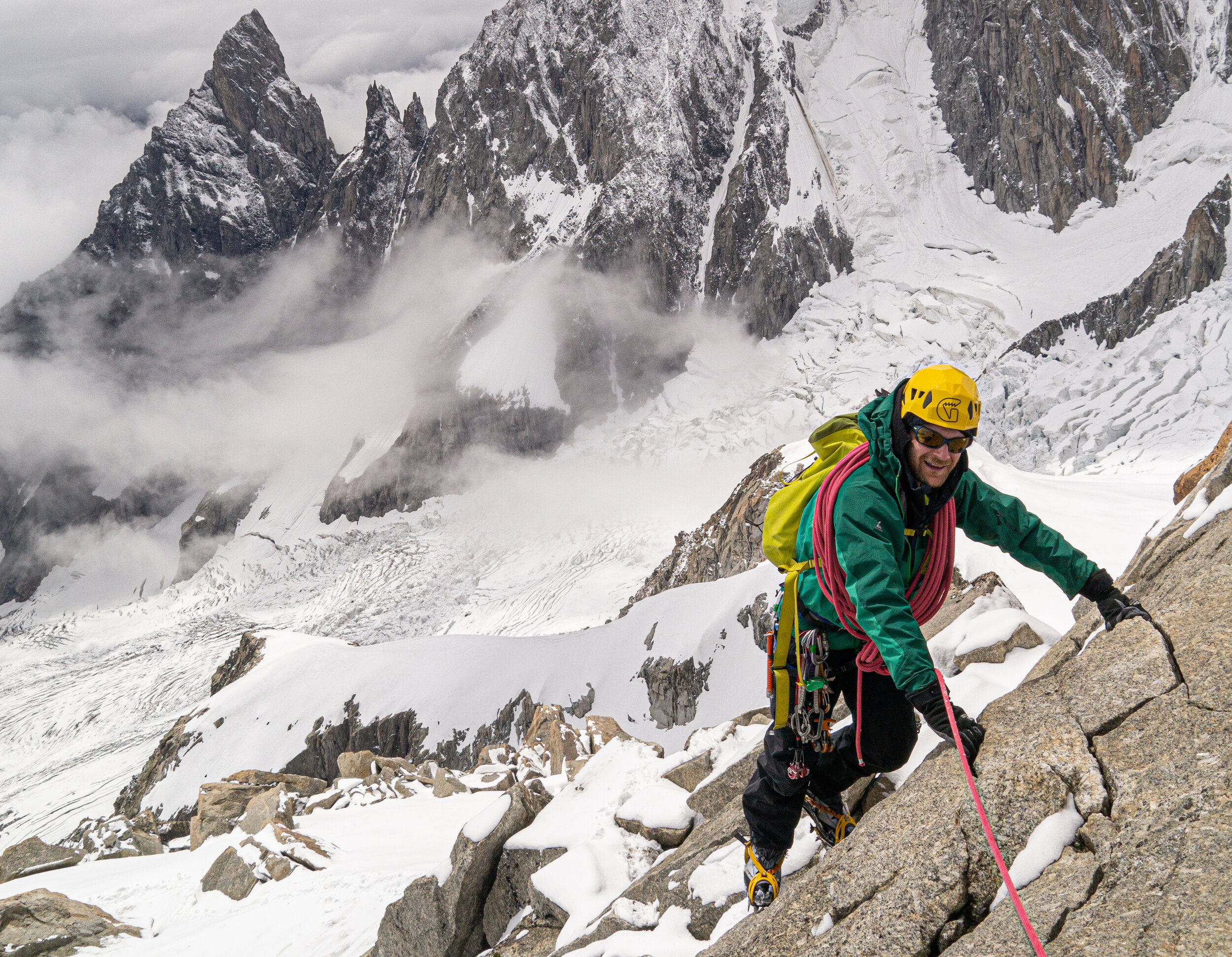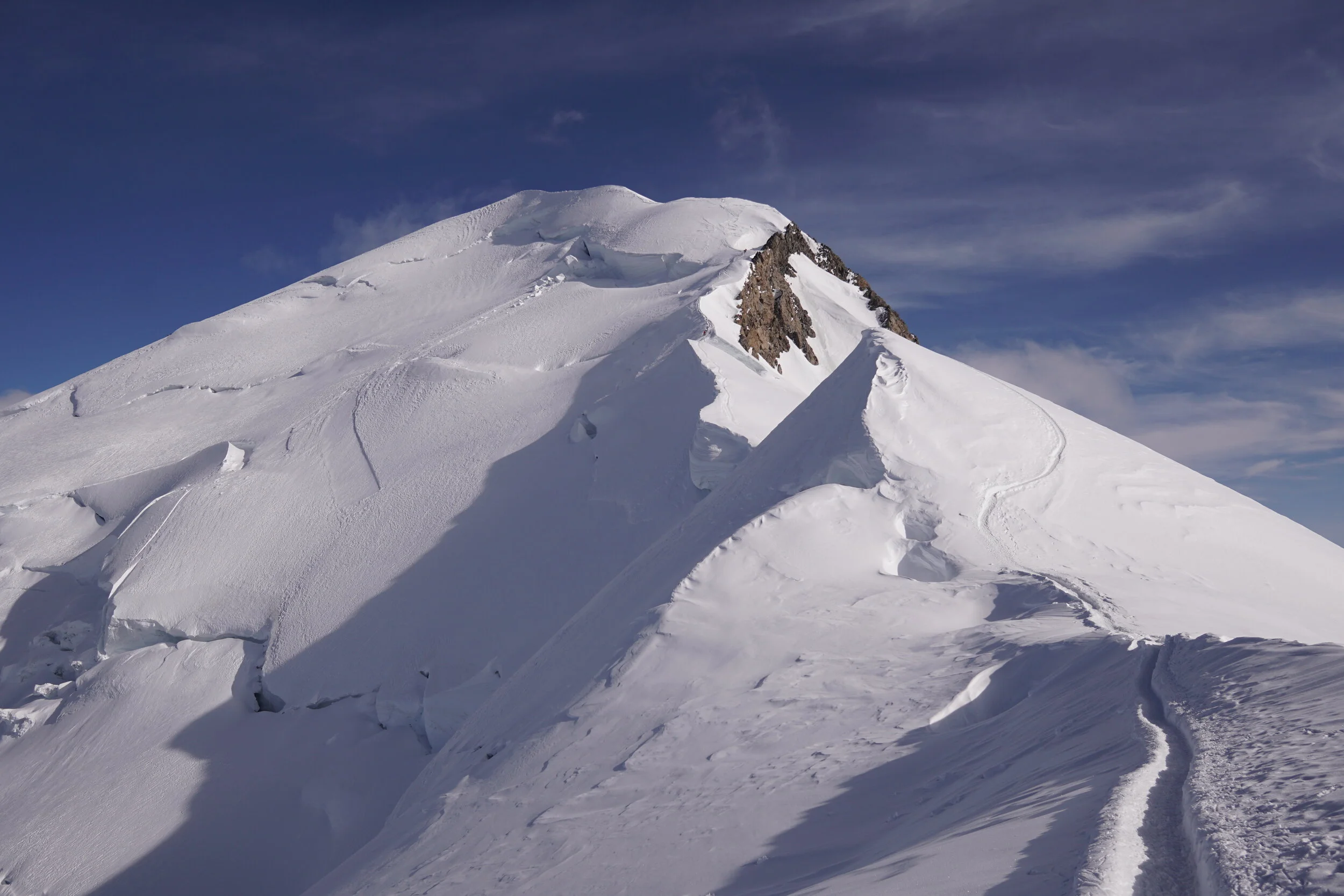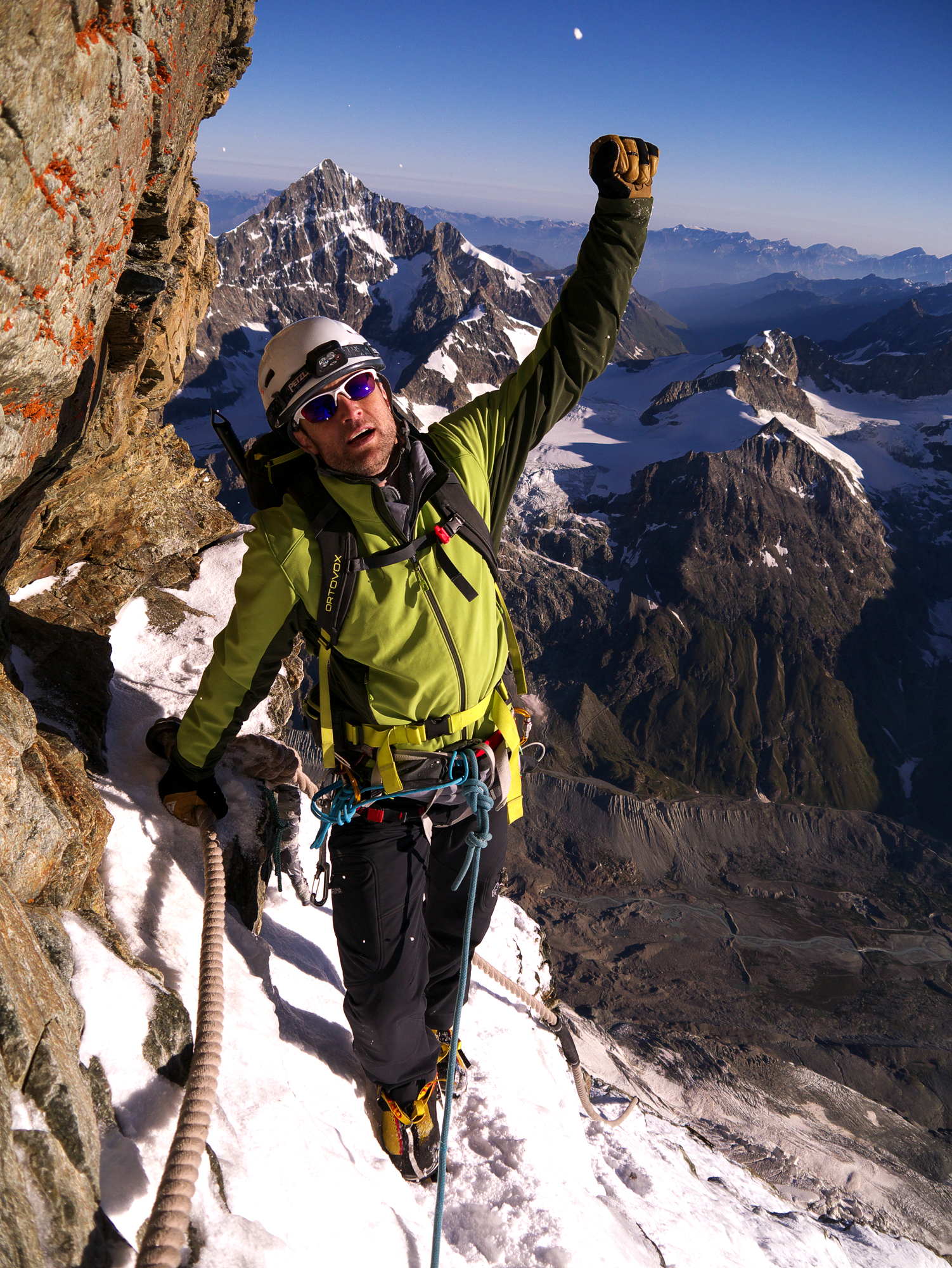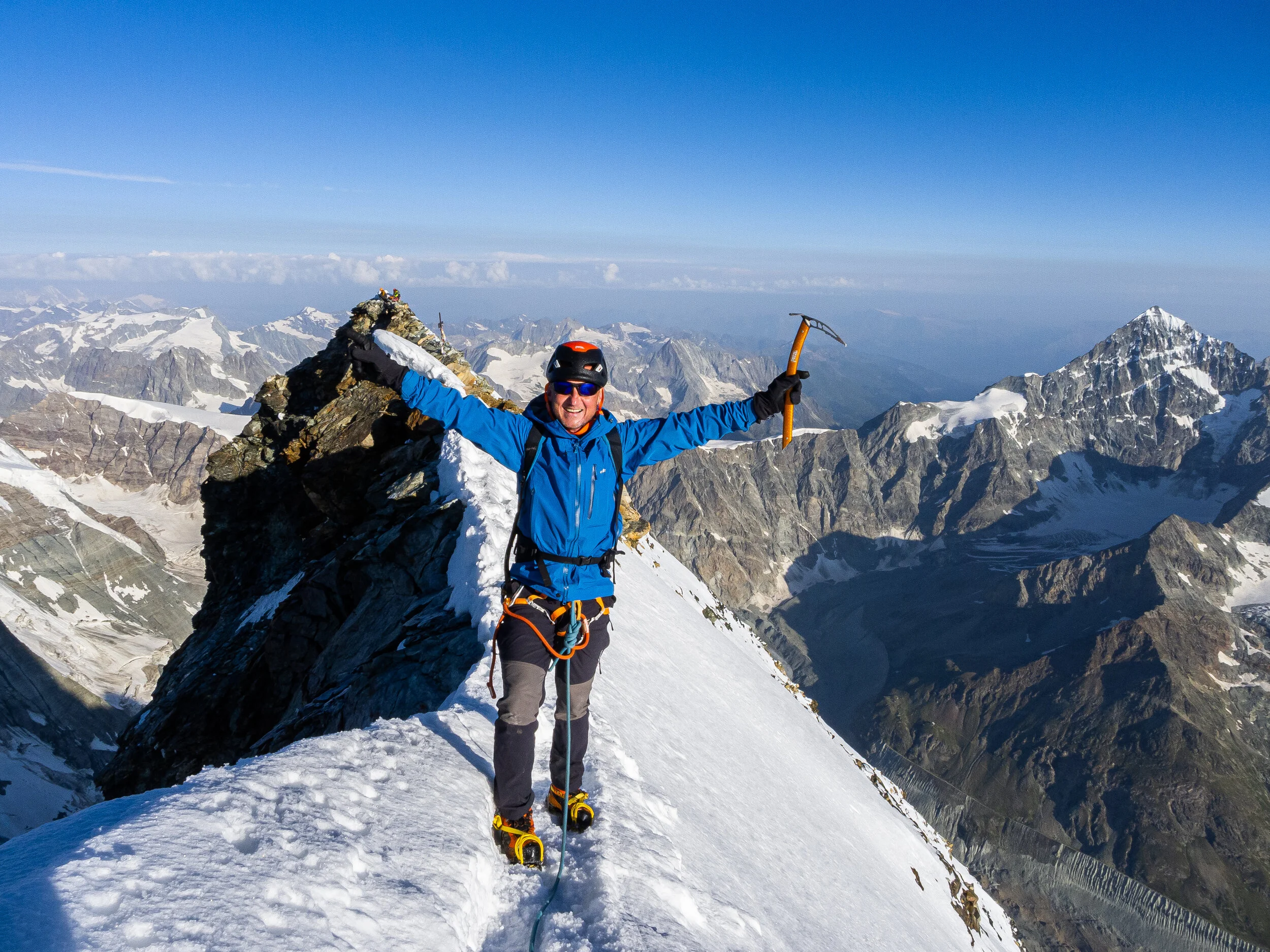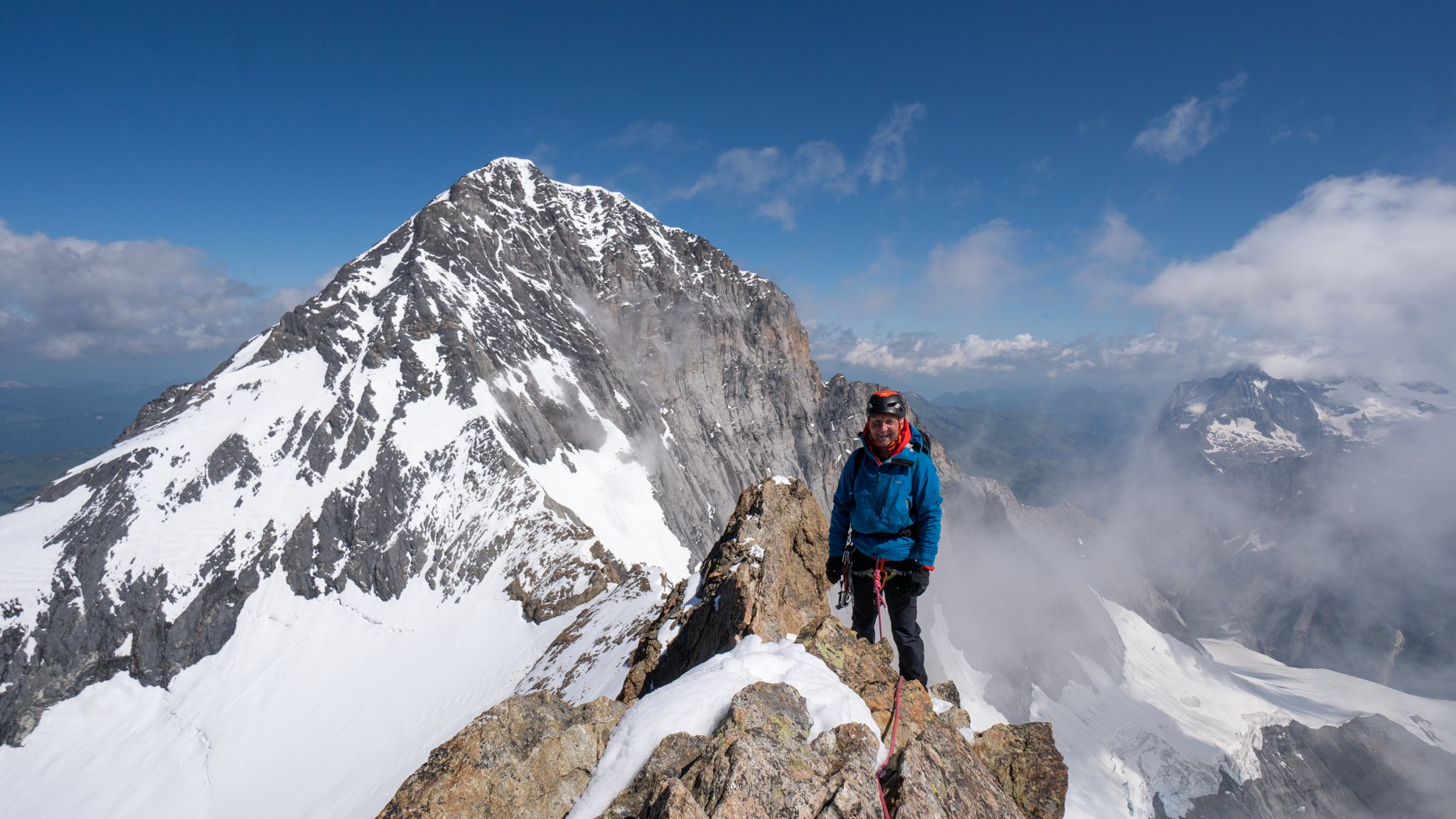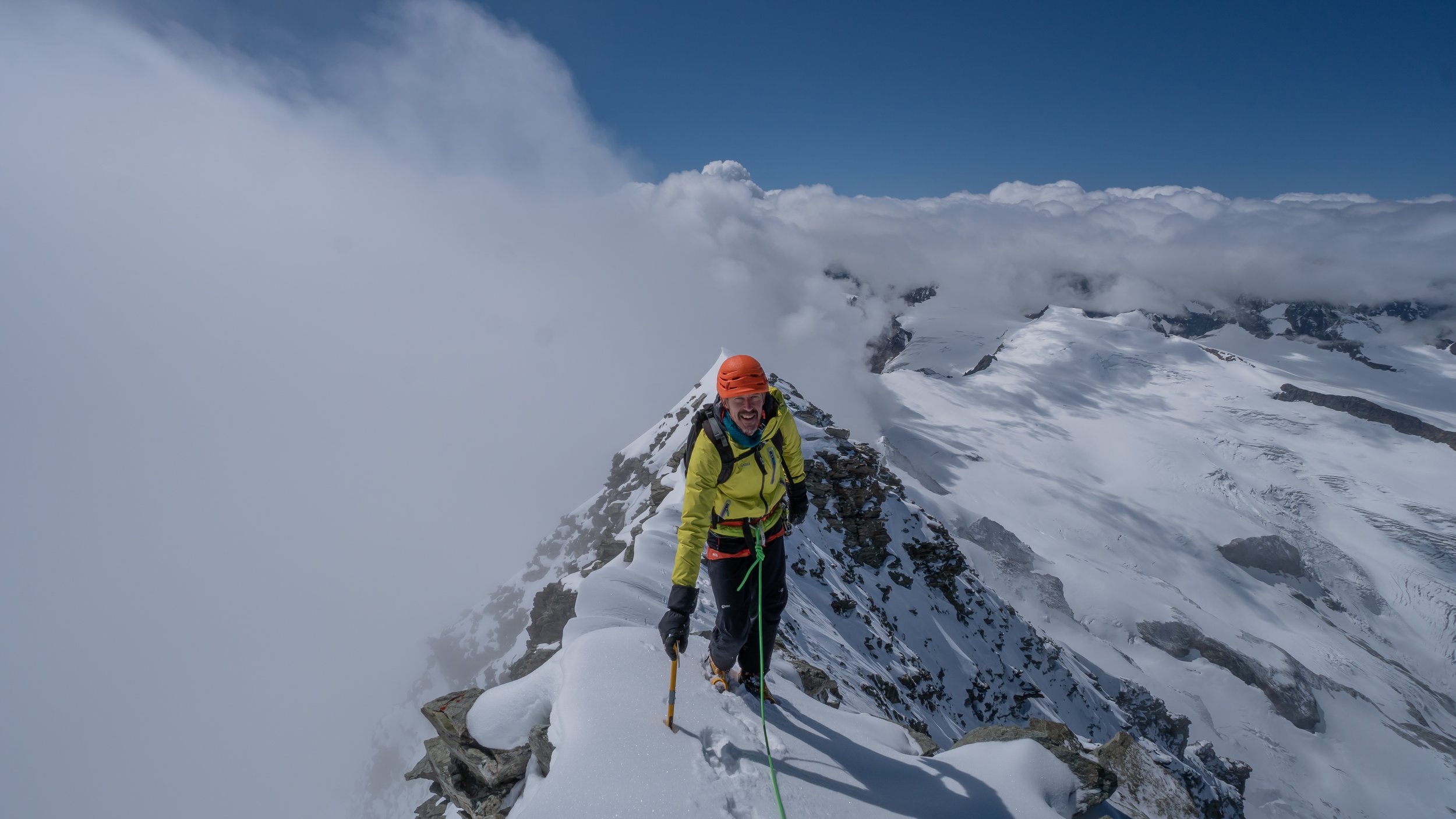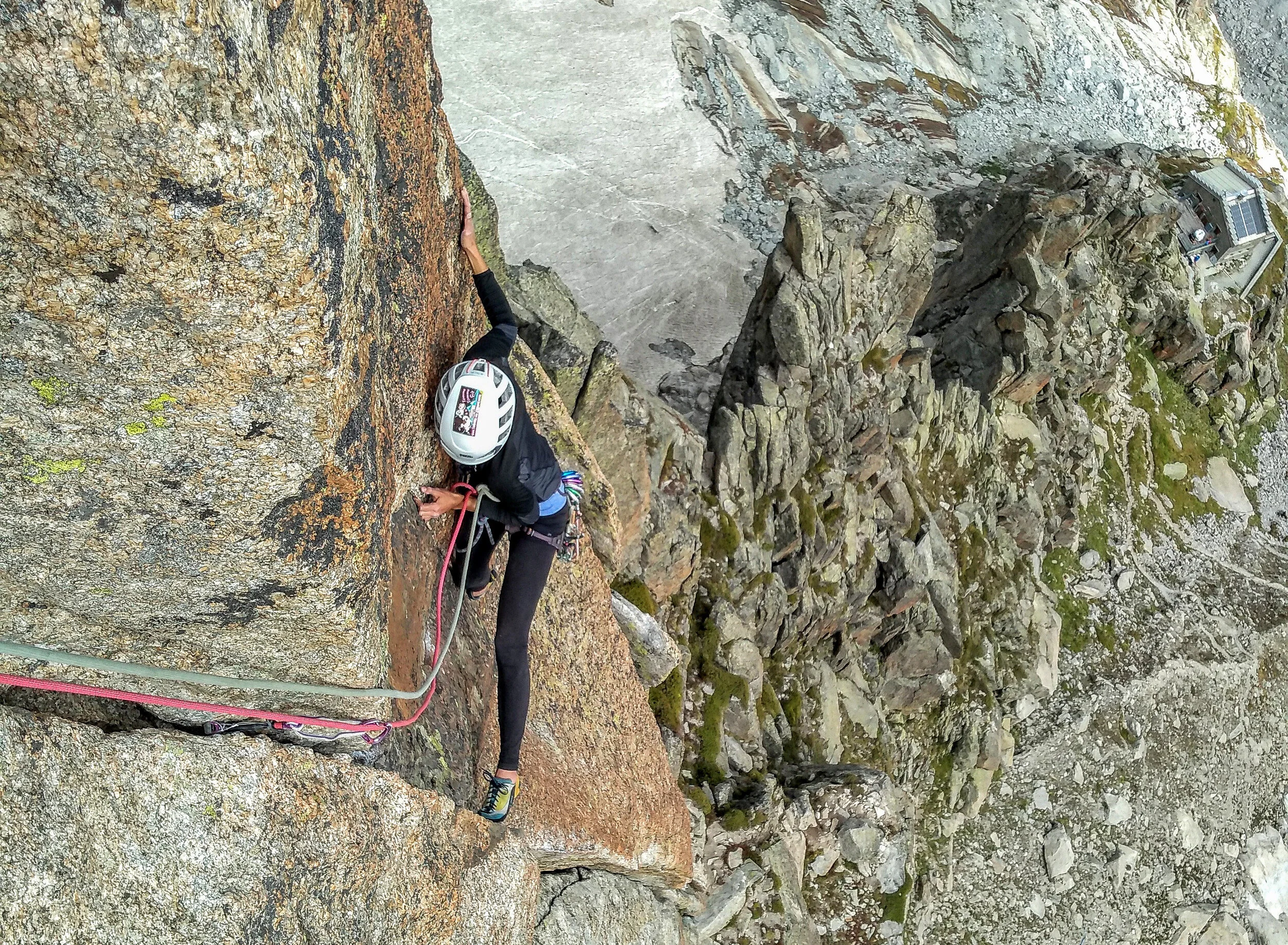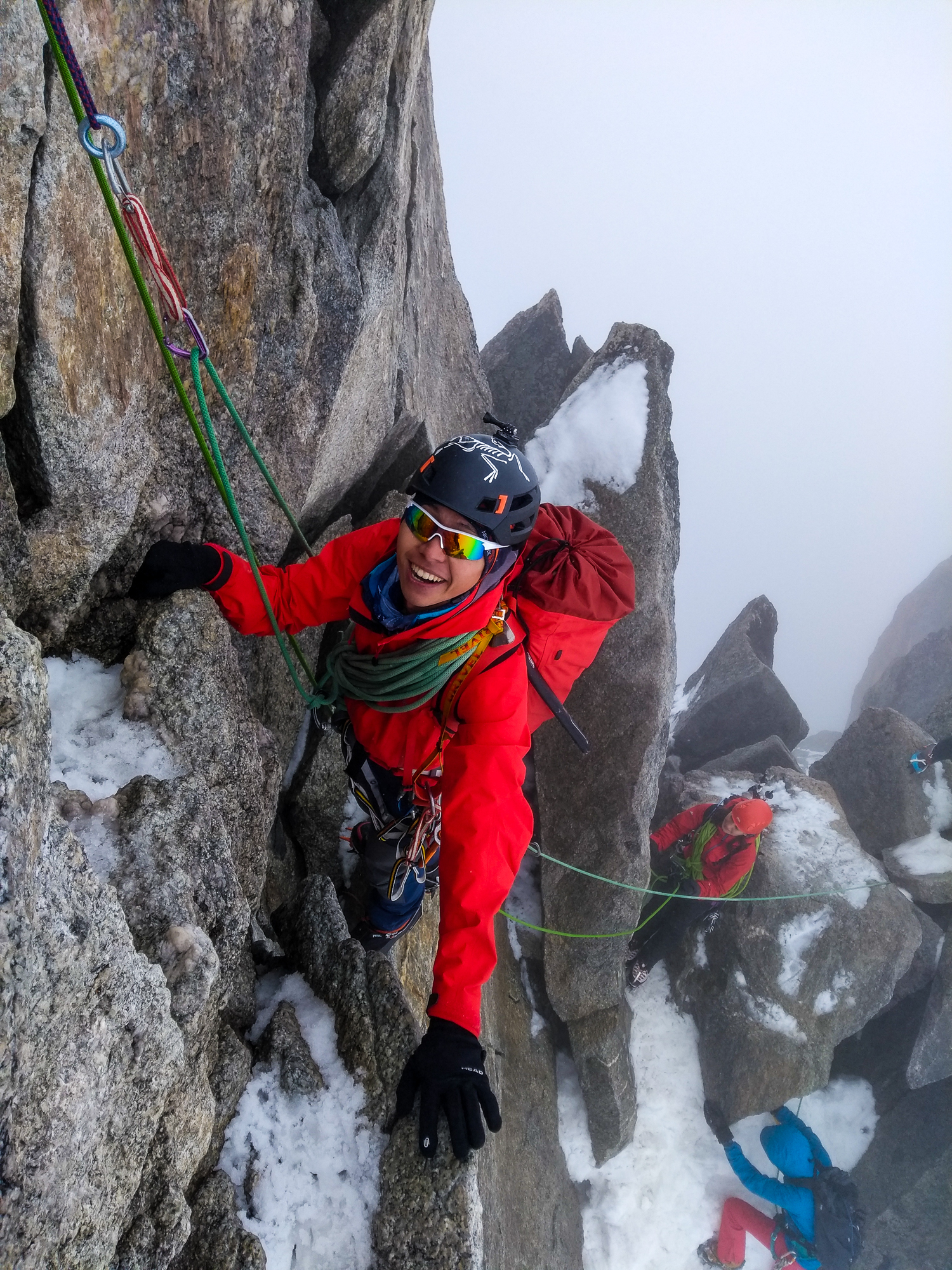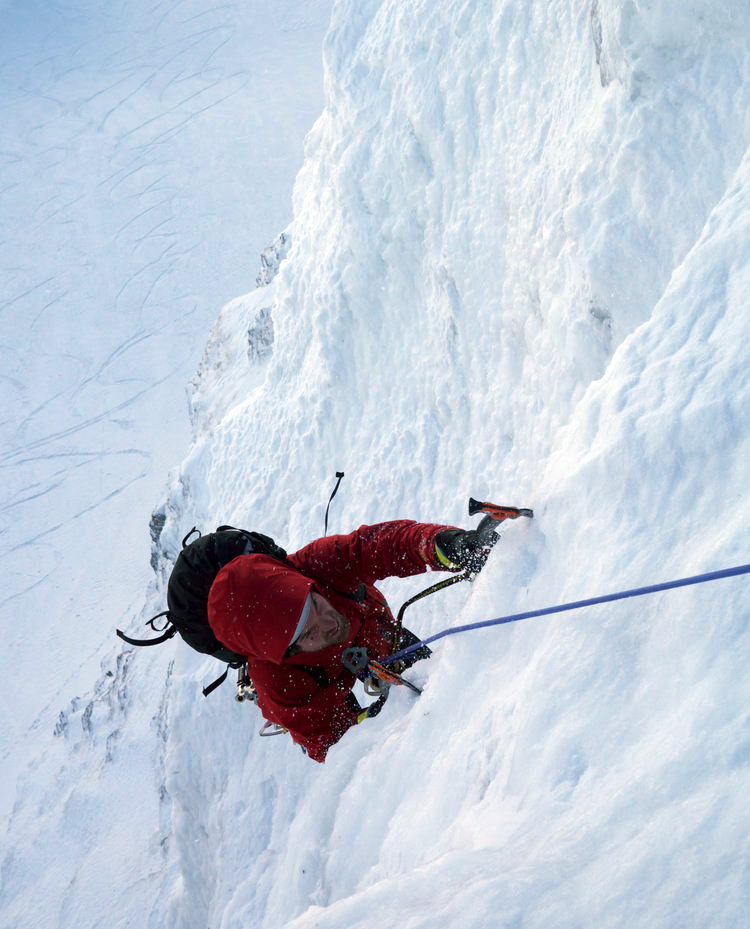
ICONIC ALPINE SUMMITS
A selection of some of the finest adventures in the alps
Andrew on the exposed upper ridge of the Dent du Géant at sunrise, the steep profile of the peak is seen on the Glacier du Géant behind.
MONT BLANC
At 4810m Mont Blanc is the highest point of the Alps and Western Europe. This course will prepare you with training and acclimatisation before making your summit bid.
GUIDED DAYS – 6
GUIDING RATIO – 1:4 / 1:2 / 1:1
from €1450 / person
MATTERHORN
Is there a summit more iconic than the Matterhorn? With three excellent ridges and a classic north face this steep and challenging climb is the highlight of many a climbers’ career.
GUIDED DAYS – 6
GUIDING RATIO – 1:2 / 1:1
from €2495 / person
DENT BLANCHE
This is a remote and wild ‘Alpinists’ peak with a long approach and a high quality climb to one of the finest summits in the Alps. A just reward for those who make the effort and a highly-prized ascent.
GUIDED DAYS – 2/3
GUIDING RATIO – 1:2 / 1:1
PrICE ON REQUEST
MONT BLANC THE HARD WAY
There are several varied routes to the summit of Mont Blanc. If you’re up for the challenge and would like to climb Mont Blanc by an alternative or more technical route then this is for you.
GUIDED DAYS – 6
GUIDING RATIO – 1:2 / 1:1
price on request
EIGER
There can be few people who haven’t heard of the Eiger and its fearsome reputation. In addition to the infamous North Face there are two challenging ridges that lead to the spectacular summit.
GUIDED DAYS – 6
GUIDING RATIO – 1:2 / 1:1
from €2750 / person
DOM
The Dom is the highest summit entirely in Switzerland and the pinnacle of the Mischabel chain - the third highest massif in the Alps. This is a good challenge in summer or on skis in the spring.
GUIDED DAYS – 2
GUIDING RATIO – 1:2
price on request
Dickie on the stunning Lenzspitze - Nadelhorn traverse in the Mischabel massif. The bulk of the Dom dominates the background.
LENZSPITZE - NADELHORN TRAVERSE
The Lenzspitze to Nadelhorn traverse is one of the great horseshoe traverses in the Alps with challenging mixed climbing, exposed steep snow slopes and a fine rocky traverse at over 4000m.
GUIDED DAYS – 2/3
GUIDING RATIO – 1:1
price on request
NADELHORN / NADELGRAT
The Nadelhorn has three great routes to the summit with the best being the long north-west ridge traverse of the Dirruhorn, Hohbarghorn and Stecknadelhorn - the mighty Nadelgrat.
GUIDED DAYS – 2
GUIDING RATIO – 1:1
price on request
ROCK CLIMBING AND
MOUNTAINEERING INSTRUCTION
Dave just below the summit of the Tour Ronde. The summit affords a spectacular view over the Brenva Glacier and the Peuterey Ridge of Mont Blanc
CHAMONIX GRANITE
The famous rocky spires above Chamonix are home to some of the best rock climbing in the world – world class climbing with chalky hands on sunny golden granite.
GUIDED DAYS – as many as you would like
GUIDING RATIO – UP TO 1:2
from €495 / day
INTRODUCTION TO ALPINISM
This course will provide you with the basic skills you need to travel safely in the mountains and will aim to culminate with your first Alpine summit!
GUIDED DAYS – 3
GUIDING RATIO – UP TO 1:4
from €695 / person
ALPINE AUTONOMY
This course is for climbers who already have some mountaineering experience and want to become independent in the mountains and will give you the skills you need to get out there on your own safely.
GUIDED DAYS – 6
GUIDING RATIO – UP TO 1:2
from €1595 / person
ROCK CLIMBING INSTRUCTION
This can be anything from an introduction to rock climbing all the way to learning how to multipitch climb or big wall climb safely, the sky is the limit!
GUIDED DAYS – OPEN
GUIDING RATIO – UP TO 1:2
from €450 / DAY
Cascade Climbing
INTRODUCTION TO ICE CLIMBING
This course covers techniques, rope-work and protection for climbing water ice and is perfect if you want to get into this ‘dark side’ of the sport.
GUIDED DAYS – 3
GUIDING RATIO – UP TO 1:4
from €525 / person
BESPOKE GUIDING
Is there is a route that has captured your imagination, a mountain you’ve seen or a summit you’ve always dreamed of reaching? Please get in touch to discuss your ideas and I’ll help you to achieve this every step of the way from preparation through to the end of your trip.
CASCADE CLIMBING
Dreaming of climbing perfect water ice under blue skies? This is all about maximum enjoyment and pumped forearms climbing classic icefalls in Europe.
GUIDING RATIO & COST – 1:1 €495
1:2 €275 per day / person
Dave on the classic ‘Sombre Heros’ in the wild and remote Queyras Massif, France
MONT BLANC

MONT BLANC 4810m
We will aim to climb Mont Blanc by the classic Gouter Route. Although there are many routes to the summit it is the most straightforward and our objective for the week. If interested in alternative routes to the Alps’ highest peak then look at the Mont Blanc the Hard Way course.
Mont Blanc at dawn
Details
The main climbing season is between June and September. June and September are quieter than July and August which are the peak (pun intended) months and can be quite busy.
We take the Bellevue cable car from Les Houches then the funicular railway to reach the Nid d'Aigle at 2367m. Here we walk up mountain paths where you frequently see Bouquetin (Alpine Ibex) which steepen and lead to the small Tete Rousse Glacier which is crossed to the Tete Rousse hut where we’ll most likely spend the night.
Above the hut we’ll get our mountaineering kit out and cross the Grand Couloir before scrambling up the rocks of the Aiguille du Gouter to reach the Gouter hut (3800m); from here the route is all on snow. The climb makes its way up the glaciated slopes of the Dome du Gouter (4304m) where you first see the upper mountain above.
Approaching the Gouter Refuge early season
We pass the emergency shelter of the Vallot hut (4362m) where the route steepens up the splendid Bosses Ridge, which is a fairly narrow and at times exposed snow arête. Above here you’ll reap the benefits of your training and preparation as the air gets thin and you feel the altitude. After carefully climbing up the ridge we gain the summit of Mont Blanc (4810m) and the pinnacle of our week.
Example Itinerary:
DAY 1: Meet at 0900 in Chamonix for the trip briefing, provision of hire kit and equipment check. We’ll have a short time to do any last minute shopping and grab lunch before driving through the Mont Blanc tunnel into Italy and the beautiful Gran Paradiso National Park. A 3 hour walk up steep mountain paths through delightful Alpages lead to the Chabod Hut (2750m) where we’ll spend the night.
DAY 2: An early pre-dawn start is needed for the 1300m ascent of Gran Paradiso (4061m) which is mainly a straightforward glacier climb with an exposed ridge scramble up the final metres to the summit Madonna. This is good training and acclimatisation and typically takes 6–8 hours. Return to the hut for a second night to aid acclimatisation.
The summit of Gran Paradiso
DAY 3: Descend to the valley and return to Chamonix. Relax and recover ready for your Mont Blanc ascent.
DAY 4: Take the cable car and train to the Nid d’Aigle (2367m) followed by a 3 hour hike up steep rocky paths to reach the Tete Rousse hut. Get an early night ready for the big day.
DAY 5: An early start of 0400 is needed from the Tete Rousse hut so we reach the Grand Couloir at daybreak. We cross this then scramble up the rocks of the Aiguille du Gouter to reach the Gouter refuge (3800m). We’ll leave a small amount of overnight equipment here before continuing the ascent over the Dome du Gouter and up the steep Bosses ridge to gain the summit with its spectacular views across the Alps. Carefully descend back to the Gouter refuge. Typically 8 hours.
DAY 6: Descend to the valley to celebrate! If we’ve been unable to summit on Day 5 this is also a contingency summit day with a very early start.
The Bosses Ridge on Mont Blanc. The final 400m of the ascent are guaranteed to take your breath away as you climb this slender and stunning ridge to the summit.
This is an example itinerary and is subject to change depending on prevailing weather, refuge availability and mountain conditions.
GUIDED DAYS: 6
GUIDING RATIO & COST: 1:1 €3250, 1:2 €1675, 1:4 €1450 per person
Suitability: This course is designed to prepare you for the rigours of climbing Mont Blanc – although previous mountaineering experience is beneficial it is not a pre-requirement. However climbing Mont Blanc is not easy, the course will be very physically demanding so you should be prepared for six days in the mountains ascending up to 1800 vertical metres on the summit day whilst carrying a pack. Mountainous day hikes carrying a pack or long bike rides of 3 hours or more will help build endurance – if you have any questions about training for Mont Blanc then please get in touch.
Jason and Anais on their final steps to the summit!
INCLUDED
IFMGA Mountain Guide(s)
Arrangement of mountain huts for the course itinerary
Provision of group safety equipment for the days on the mountain
Local travel required to complete the course itinerary
Uplift costs for your Mountain Guide (in the Chamonix valley area only)
Assistance in arranging local accommodation
NOT INCLUDED
Travel to and from Chamonix,
Accommodation in the valley
Uplift costs (including for your Mountain Guide outside of the Chamonix valley area)
Personal mountaineering equipment (this can be hired at the prices detailed below)
Half board accommodation for our nights in mountain huts (including for your Mountain Guide)
Insurance which must include provision for helicopter rescue (mandatory). If you require recommendations for insurance providers then please get in touch.
EQUIPMENT HIRE
Ice axe, crampons, harness and helmet can be provided for a hire fee of €15 per day. Mountaineering boot hire can be arranged with Snell Sports in Chamonix.
MONT BLANC
THE HARD WAY

MONT BLANC THE HARD WAY
We will aim to climb Mont Blanc by an alternative to the classic Gouter Route. There are many routes to the summit of different character and difficulty but all of them are classic outings amongst the best in the Alps at their respective grades.
Have a look at the following suggested routes and get in touch to ask questions or make a booking. All bookings on these courses are private and can be run from May through October depending on conditions.
Approaching the Pope Route. The long journey to the rifugio Gonella takes you up some impressive glaciated terrain
THE TROIS MONTS – AD- (A bit tricksome)
This used to be one of the most frequented routes on Mont Blanc as it is a very picturesque traverse over Mont Blanc du Tacul (4248m) and Mont Maudit (4465m) then past the spectacular col Brenva up to the summit. Due to glacial changes in recent years the route has become steeper and more serious and in 2017 the guiding ratio was lowered to 1:1 for this route. Under the right conditions it provides a spectacular way of reaching the Alps’ highest summit and when combined with the Gouter route a fine horseshoe traverse.
GUIDED DAYS: 6
GUIDING RATIO & COST, 1:1 €3295
Dave on the Pope Route. The Royal traverse climbs the very narrow crest in the background.
THE AIGUILLE GRISES (THE POPE ROUTE) – PD+ (Technically not hard but long and remote)
The normal route from the Italian side of the mountain is long and remote without the benefits of mechanical uplift like the French side. As such it is less frequented and is a satisfying mountaineering adventure especially when combined with a descent down the Gouter route to Chamonix making a traverse of the mountain.
GUIDED DAYS: 6
GUIDING RATIO & COST, 1:1 €3395, 1:2 €1750 per person
THE ROYAL TRAVERSE – AD (Hard enough)
This is a splendid and committing high mountain odyssey which traverses the skyline view as seen on the approach towards Mont Blanc down the Arve valley. Starting from the village of Les Contamines-Montjoie without lifts we traverse the Dome de Miage to reach the remote Refuge Durier (3358m). The traverse continues over the Aiguille de Bionnassay (4053m) where the summit ridge is one of the most impressive narrow and exposed snow crests in the Alps - only perfect crampon work will do. This brings us past the Piton des Italians to the final climb up the Bosses ridge to the summit of Mont Blanc (4810m). Descent can be via the Trois Monts route to the Aiguille du Midi (if in condition) or down the Gouter Ridge. This is a long and demanding Alpine day which rewards good fitness and preparation.
GUIDED DAYS: 6
GUIDING RATIO & COST, 1:1 €3500
The sensationally exposed traverse of the Aiguille Blanche de Peuterey
THE INNOMINATA RIDGE – D+ (On the difficult side of difficult)
A remote and committing climbers’ route to the summit of Mont Blanc from the Italian side. We climb through some of the most chaotic glaciated terrain in the Alps to gain the Col Eccles (4000m) before climbing excellent granite, steep snow crests and mixed ground to reach Mont Blanc de Courmayeur. In true style we then traverse over the summit and descend into France.
GUIDED DAYS: 6
GUIDING RATIO, 1:1 PRICE ON REQUEST
THE PEUTEREY INTEGRALE – ED (Extremely difficult and they aren’t kidding!)
The big one. Literally, this is the longest ridge and route in the Alps with a cumulative ascent of nearly 4500m and is a rarely completed and serious undertaking. Seen from the Skyway lift in profile the ridge is a compelling line and undoubtedly one of the finest in the Alps with technical difficulties on both rock and mixed terrain. The ascent climbs over the rocky towers of the Aiguille Noire de Peuterey (3772m) before making some of the most exposed abseils in the Alps to regain the ridge which leads over the steep snow crest of the Aiguille Blanche de Peuterey (4112m). The final hurdle is ‘just’ the 800m climb up the seriously exposed upper Peuterey ridge to the summit of Mont Blanc before descending the French side. Three long days and two bivouacs are the norm!
GUIDED DAYS: 6
GUIDING RATIO, 1:1 Price on request
The ski ascent of Mont Blanc via the Grand Mulets route is described in the ski section.
Serious and exposed terrain high on the Italian side of Mont Blanc
INCLUDED
IFMGA Mountain Guide
Arrangement of mountain huts for the course itinerary
Provision of group safety equipment for the days on the mountain
Travel required to complete the course itinerary
Uplift costs for your Mountain Guide (in the Chamonix valley area only)
Assistance in arranging local accommodation
NOT INCLUDED
Travel to and from Chamonix,
Accommodation in the valley
Uplift costs (including for your Mountain Guide outside of the Chamonix valley area)
Personal mountaineering equipment (this can be hired at the prices detailed below)
Half board accommodation for our nights in mountain huts (including for your Mountain Guide)
Insurance which must include provision for helicopter rescue (mandatory). If you require recommendations for insurance providers then please get in touch.
EQUIPMENT HIRE
Ice axe, crampons, harness and helmet can be provided for a hire fee of €15 per day. Mountaineering boot hire can be arranged with Snell Sports in Chamonix.
THE MATTERHORN

THE MATTERHORN 4478m
The Matterhorn is truly an iconic summit and one known by many non-mountaineers worldwide. If you asked a child to draw a mountain they would likely draw something similar to this steep rocky pyramid that looms over Zermatt. Not only is it the world’s most photographed peak but it’s also the ‘Toblerone Mountain’.
For years the summit was thought to be impregnable until the incredible first ascent by Edward Whymper and party in 1865. The famous tragedy that then ensued during the descent only reinforced the mountain’s reputation and is likely to have inspired his timeless quote:
“Climb if you will, but remember that courage and strength are nought without prudence, and that a momentary negligence may destroy the happiness of a lifetime. Do nothing in haste; look well to each step; and from the beginning think what may be the end.”
― Edward Whymper, Scrambles Amongst the Alps, 1871
This course will prepare you for the 1200m summit climb with 3 days of technical training and acclimatisation around the Mont Blanc Massif before heading to Zermatt and the Hornli Hut below the famous Hornli Ridge.
The ridge rears up steeply behind the hut where a fixed rope helps us to get up the initial steep rock wall to ledges. From here the route follows a system of ledges and gullies on the East flank of the ridge with continuous and sustained scrambling leading to the Solvay Hut (4003m) – a small emergency shelter. Above the Solvay hut we scramble to the shoulder and climb some steeper sections where in places there are fixed ropes to aid going up and down. The final section to the summit is on mixed terrain where careful crampon work is required to reach the summit (4478m).
Ideally we want most of the section below the Solvay to be quite free of snow as it greatly hinders progress up the lower peak. As such the best time of year for an ascent is in July and August.
Daniel ascending fixed ropes on a snowy Hornli Ridge
Michael on the summit midway through a traverse of the Matterhorn - Lion Ridge to Hornli Ridge
Example Itinerary
DAY 0: Travel to Chamonix. Meet at 1900 in Chamonix for the trip briefing, provision of hire kit and kit check.
DAY 1: We’ll head out locally onto a technical training route to practise moving efficiently over rocky terrain and get warmed up for the week ahead. The traverse of the Perrons on the Swiss border is a perfect candidate for today with lots of scrambling, some climbing as well as some abseils and lowers to get used to the ropework required. Typically around 8 hours.
DAY 2: We’ll take the Mont Blanc tunnel through to Italy and use the Skyway lift to get access to the high mountains on the Italian side of the Massif. There are several good training peaks on this side, the Marbrees, Entreves and Tour Ronde Freshfield arête being good training at altitude. We’ll spend the night at the Torino Refuge (3375m).
DAY 3: A second training route at altitude before descending on the Skyway and returning back to Chamonix.
DAY 4: We’ll travel over to Tasch and take the train to Zermatt before using the uplift system to get to Schwarzee. Here we’ll walk in to the Hornli Hut and may make a quick recce of the lower part of the ridge in the afternoon to prepare for the next day’s climb.
DAY 5: An early start at 0330 means we’re climbing the lower section of the mountain by headlamp but this is rewarded when the sun comes up and we’re already a long way up the ridge. We’ll keep pushing up the Hornli ridge to gain the Swiss summit before traversing the exposed crest between the Swiss and Italian summits before returning back down the route to the hut. This isn’t to be underestimated and it frequently takes longer to descend the ridge than to climb it! 9–12 hours.
DAY 6: Return to the valley and drive back to Chamonix to celebrate your climb. This day can also be used as a second summit day if the weather or conditions don’t allow it on DAY 5.
—
GUIDED DAYS: 6
GUIDING RATIO & COST, 1:1 €3750,
1:2 €2495 per person
For more experienced climbers the ascent of the Lion ridge (AD+) from Cervinia is an excellent and more challenging route up the Matterhorn where rock climbing skills are invaluable. This makes for an aesthetic traverse with a descent of the Hornli ridge and return to Italy using the Zermatt-Cervinia lift systems.
The Matterhorn can also be climbed via the Zmutt Ridge (D+) with a descent down the Hornli making a horseshoe traverse of the mountain. This ascent is long, remote and serious, for the serious Alpinist! Please get in touch if you’re interested in this or the North Face Schmidt Route.
Suitability: This course is designed to prepare you for the challenge of climbing the Matterhorn. Previous mountaineering experience is essential with the ability to move efficiently on broken mixed terrain the key to success. Climbing the Matterhorn is not easy! The course will be very physically demanding so you should be prepared for six days of climbing technical terrain in the mountains ascending up to 1300 vertical metres in a day whilst carrying a pack. Mountainous hikes and scrambles carrying a pack or long bike rides of three hours or more will help build endurance and improve your technical skill – if you have any questions about training for the Matterhorn then please get in touch.
INCLUDED
IFMGA Mountain Guide(s)
Arrangement of mountain huts for the course itinerary
Provision of group safety equipment for the days on the mountain
Travel required to complete the course itinerary
Uplift costs for your Mountain Guide (in the Chamonix valley area only)
Assistance in arranging local accommodation
Rob high on the Lion Ridge of the Matterhorn - The mountain casts a very distinctive silhouette
NOT INCLUDED
Travel to and from Chamonix,
Accommodation in the valley
Uplift costs (including for your Mountain Guide outside of the Chamonix valley area)
Personal mountaineering equipment (this can be hired at the prices detailed below)
Half board accommodation for our nights in mountain huts (including for your Mountain Guide)
Insurance which must include provision for helicopter rescue (mandatory). If you require recommendations for insurance providers then please get in touch.
EQUIPMENT HIRE
Ice axe, crampons, harness and helmet can be provided for a hire fee of €15 per day. Mountaineering boot hire can be arranged with Snell Sports in Chamonix.
THE EIGER

THE EIGER 3967m
With its famous north face the Eiger (Ogre in Swiss German) is one of the most recognisable and famous summits in the Alps, if not the world. Luckily for the mortal alpinist the peak sports two ridges of different characters; both of which make for superb expeditions and are among the finest at their grades in the Alps.
There are several variations to this trip so we will work with the conditions in the mountains to give us the best chance of reaching the summit. Ideally we will aim to ascend the Mittellegi ridge and descend the South ridge to the Monchjoch by traversing the mountain. For those with a good technical climbing level there is also the option of the Mittellegi Integral traverse starting from the valley and climbing the ridge in its entirety. Another option is to make the ascent via the South ridge and return back to the Monchjoch via the same route. This ridge has a wild and remote feel and is also a highly prized ascent.
Mike descending the south ridge of the Eiger after climbing the Mittellegi up the right-hand skyline
Ally on the exposed finale to the MIttellegi ridge
The Eiger North Face
Example Itinerary
DAY 0: Travel to Interlaken. Meet at 1900 in Interlaken for the trip briefing, provision of hire kit and kit check.
DAY 1-3: We’ll head up the famous Jungfraujoch railway (which travels through the Eiger) into the stunning Bernese Oberland where we will make some preparatory climbs to get acclimatised to the altitude and ensure that we are moving efficiently over mixed high mountain terrain. Possible climbs may include the Monch (4107m), Jungfrau (4158m), Gross Grunhorn (4049m) and Trugberg (3933m). These days can be run at a ratio of 1:2.
DAY 4: We’ll return to the Jungfraujoch railway and the Mittellegi or Monchjoch Hutte depending on our chosen route, meet the second guide and get an early night.
DAY 5: Summit day. Make an early start for either the rocky Mittellegi ridge or a snowy glaciated approach to the South ridge before our intended climb. Descend to Kleine Schiedegg or return to the Monchjoch Hutte.
DAY 6: Contingency summit day or we can make the most of an extra day by doing some local climbing or a day trip from the Jungfraujoch before heading back to Interlaken to celebrate.
—
Course cost, 1:1 €3795, 1:2 €2750 per person
Suitability: This course is designed to prepare you for the challenge of climbing the Eiger. Previous mountaineering experience is essential with the ability to climb UIAA 4+ on rock in big boots, move efficiently over tricky mixed terrain and safely along exposed snow crests. This is a serious and committing undertaking and will both very physically and mentally demanding. You should be prepared for six days of climbing technical terrain ascending up to 1300 vertical metres a day whilst carrying a pack. Aerobic fitness and endurance is crucial for long days in the high mountains. Mountainous hikes and rocky scrambles carrying a pack and long bike rides or runs up to 3 hours or more will help build endurance and improve your technical skill. If you have any questions about specific training for the Eiger or to climb other routes including the classic North Face 1938 route please get in touch.
INCLUDED
IFMGA Mountain Guide(s)
Arrangement of mountain huts for the course itinerary
Provision of team safety equipment for the days on the mountain
Guide’s travel and uplift required to complete the course itinerary
Guide’s hotel nights in Interlaken
Assistance in arranging local accommodation
NOT INCLUDED
Travel to and from Interlaken,
Accommodation in Interlaken
Uplift costs
Personal mountaineering equipment (this can be hired at the prices detailed below)
Half board accommodation for our nights in mountain huts (including for your Mountain Guide/s)
Insurance which must include provision for helicopter rescue (mandatory). If you require recommendations for insurance providers then please get in touch.
EQUIPMENT HIRE
Ice axe, crampons, harness and helmet can be provided for a hire fee of €15 per day. Mountaineering boot hire can be arranged in Interlaken or Grindlewald.
DENT BLANCHE

DENT BLANCHE 4357m
The asymmetric pyramid of the Dent Blanche is a striking sight from all points of the compass and is recognisable from afar. The peak dominates the head of the Val d’Hérens in the Swiss Valais and steadily becomes more imposing as you travel up the valley from Sion. There was confusion in the naming during the early mapping of the Alps as this is truly the ‘Dent d’Hérens’ and the modern day Dent d’Hérens with its glaciated north face should have been the Dent Blanche.
This is definitely one of the great peaks of the Alps and it is no surprise it is one of the Swiss ‘big three’ along with the Matterhorn and Eiger. With no mechanical uplift and a long approach up a wild valley to reach the small Cabane de la Dent Blanche this peak rewards only the most determined Alpinists and is a prized ascent.
John on the final ridge to the summit of the Dent Blanche in snowy conditions
Breaking trail up the south ridge above the Wandfluelücke on a beautiful Alpine morning
The approach to the hut starts at the barrage de Ferpècle and winds its way up through a beautiful alpage, over moraines and finally the small glacier de Manzettes to reach the small Cabane Rossier perched at 3507m. This is a less frequented, wild and stunning valley where I’ve even seen a wolf casually minding its own business! Good fitness is essential as this approach is a solid 4-5 hours and almost 1800m of height gain – plus you want to feel fresh for the summit day.
The climbing starts right behind the hut with some rocky scrambling to gain the small suspended glacier and the Wandfluelücke col at the base of the south ridge. We aim to be here for the first morning light and it is a beautiful sight seeing the sun coming up over Monte Rosa and the nearby Matterhorn. The route climbs snow and easy mixed ground over a small fore-summit before following the ridge to the base of the Grand Gendarme and the upper ridge proper. This rocky tower looks intimidating from below but actually climbs really well at an amenable grade. Under mixed or snowy conditions we avoid this by climbing a snowy couloir to the west of the ridge which leads to the crest above the gendarme.
Spectacular but never excessively hard rock climbing leads along the crest past 5 rocky towers to a sensational final mixed ridge to the summit. This is frequently corniced on the east side and demands sound judgement. I think this summit is one of the finest in the Alps and due to the adventurous nature of the ascent for me this is even better than its more illustrious neighbour, the Matterhorn.
The descent is back down the line of ascent via a mixture of down-climbing, rappelling and lowering which isn’t to be underestimated. We can take an optional second night in the hut if the legs are feeling tired otherwise we will crack on with the long descent back to Ferpècle and the car.
There are two other challenging ridges that may interest the hardened Alpinist searching for an adventure. Both are more difficult than the south ridge and rarely climbed. The Arête de Ferpècle or west ridge is D+, 5a and approached from Ferpècle via a bivouac. The Arête de Quatre Ans is D, 3c and whilst not technically difficult is a wild and serious climb from the Val d’Anniviers. The name doesn’t come from the four rocky towers on the ridge (a common misconception) but from the statement of the first ascensionists who announced on their arrival at the summit: ‘We are but four asses for having climbed this route!’
LENZSPITZE-NADELHORN

LENZSPITZE 4294m
The Lenzspitze is a sometimes overlooked technical 4000m peak overshadowed by its larger and technically easier neighbours, the Nadelhorn and the Dom. When there is a line of climbers daily climbing up the Nadelhorn normal route you are likely to have a much quieter experience here and finding yourself high on the peak as the sun rises on your back is unforgettable.
The easiest route is the south ridge from the Dom hutte but this is quite loose and rarely climbed. The best route to the summit is the sharp NNE ridge with a continuation traverse above 4000m to the summit of the neighbouring Nadelhorn and descent of the normal route. This makes for a rewarding, fantastic and varied high mountain traverse with difficulties on both snow and rock.
The approach to the Mischabel Hut from Saas Fée is a solid climb in itself and is sometimes done just to spend the night in this high hut. Maria and team have made this one of the most welcoming and friendly huts in the Alps, an added bonus in addition to the great mountaineering on the peaks above. Even using the lift up to Hannig the approach is a solid 3-4 hours with the final hour being scrambling up a rocky ridge to reach the hut.
The ENE ridge of Lenzspitze weighs in at AD+ 3c, despite the modest rock climbing grade there is a lot of climbing both on the ridge and on the traverse to the Nadelhorn where the exposure makes it all feel somewhat more difficult! An early start from the hut is essential to ensure that we arrive at the snowy upper ridge whilst the snow is still in good condition, not much consolation for the 0300 start but after a couple of hours by headlamp we are rewarded with a stunning sunrise as we are already are high on the ridge.
The initial climb to c. 3800m is quite steady but then the ridge becomes steeper, narrower and much more impressive. From below it looks much harder than it is and as we arrive at the grand gendarme - a steep rocky tower that blocks the ridge - it looks almost impassable. This climbs really well with several short pitches leading to its top and the continuation rocky ridge which finally becomes a really steep and spectacular snow crest which teeters across the top of the North-east face in an amazing position to reach the summit with a miniature madonna.
The day is far from over here though as we descend the narrow rocky ridge with some short scrambling sections, lowers and possibly a rappel depending on the conditions to reach the Lenzjoch. This spectacularly situated small col sits halfway between the Lenzspitze and Nadelhorn and last time I guided it we were surprised by a Swiss fighter jet passing inverted about 100m above us before barrelling down the other side. A proper ‘top-gun’ moment. From here the ridge climbs steadily up a series of rocky towers and traverse to reach the large summit cross of the Nadelhorn at 4327m. From here we descend the PD normal route on the Nadelhorn down snow and easier scrambling to return to the Mischabel hut and a well deserved drink after a long day.
In addition to the ENE ridge there is also the possibility of climbing the NE face or Drieselwand from the Mischabel hut. This is a classic snow/ice face at up to 50 degrees and when linked into the traverse to the Nadelhorn makes a great day out at D. Or the other alternative would be to ski back down!
Jake on the crest the ENE ridge of Lenzspitze
Jake on the ENE ridge of Lenzspitze at sunrise
Rich and Dickie climbing high up the edge of the Drieselwand
NADELGRAT

NADELHORN 4327m
The mighty Nadelhorn is the highest peak at the northern end of the Mischabel chain and has three excellent ridges that lead to the summit. The first ascent in September 1858 was a tour de force with the party leaving from the valley by lantern light and climbing up to the Schwarzhorn where they collected wooden beams before carrying these up the north-east ridge from the Windjoch. They then assembled a summit cross before descending. This ridge is a lot narrower and rockier than the wide snowy crest that the first ascensionists encountered and the route remains justifiably popular.
For the experienced Alpinist the Lenzspitze-Nadelhorn traverse (described above) or the northwest ridge, the Nadelgrat are the obvious challenges. The Nadelgrat traverse from the Dirruhorn to the summit via the Hohbarghorn and the Stecknadelhorn is one of the best mixed ridge climbs in the Alps and an unforgettable day out.
Andrew on the ascent to the Hohbarghorn with the Dirruhorn behind
Donal high on the Nadelgrat with the Hohbarghorn (left) and Stecknadelhorn behind
There are two possible approaches to the Nadelgrat; from the Bordier hut to the north or from the Mischabel hut - the same as described in the approach for the Lenzspitze. From either approach a very early start is required to gain the Riedgletscher plateau at 3500m just before dawn. From the Mischabel hut we climb up to the Windjoch and then over the summit of the Ulrichshorn, 3924m in the dark before descending down to the Riedgletscher and traversing to the base of the Selle Couloir at 3500m. This couloir faces east-northeast and gets the first sun of the day so it is essential we arrive here before 6am. Quite the approach!
The proper climbing starts here as we climb the 45 degree couloir to reach the ‘selle’ a small saddle north of the Dirruhorn at 3858m. Once here we can relax the pace a little as we are out of objective danger. The climb to the Dirruhorn is a fun rocky scramble with a short steeper step just below the summit which climbs really nicely despite initial appearances and we gain the first of todays summits at 4035m. The continuation ridge is fun and exposed scrambling which gradually eases as we descend to the Dirrujoch col and set our focus on the next summit.
Ideally we would climb this last section without crampons and the climb to the Hohbarghorn starts out as more rocky scrambling before we put our crampons back on and make a steep traverse up the side of the snowy ridge. This arrives at an ominous steepening where delicate but never difficult mixed climbing in crampons regains the ridge above and the exposed summit of the Hohbarghorn, 4218m.
The descent to the Hohbargjoch goes quickly until we reach the upper ridge of the Stecknadelhorn where delicate mixed climbing and scrambling lead up the exposed rocky ridge to the sharp summit of the Stecknadelhorn, 4220m and it’s summit cross. A quick scramble down leads to another splendid snow crest that keeps getting steeper until it reaches the final steep rocky tower on the ridge. This looks impassable and many teams make an exposed traverse across the snow slope to gain the Nadelhorn normal route however the steep gendarme passes with a short pitch of rock climbing and brings us to just below the Nadelhorn summit. A final few metres of mixed climbing and we arrive at the summit cross of the Nadelhorn, 4327m and stunning views over the great peaks of the Valais.
The descent down the Nadelhorn voie normale goes quite quickly and within an hour or two we arrive back at the Mischabel hut for some well deserved food and a drink. Definitely deserved after traversing four 4000m peaks that day.
Whilst the grade of AD 3c appears moderate this is a long and committing route with a lot of climbing above 4000m. Good acclimatisation and the ability to move well on snow, rock and mixed terrain in mountaineering boots and with crampons is more important than technical ability. The best period of the year for this route is generally early summer or during a wet and snowy summer when the entry couloir is snowy and well frozen and the upper ridge is not icy. This is a classic Alpine adventure that should be on every alpinists ticklist.
CHAMONIX
GRANITE

CHAMONIX GRANITE
The Mont Blanc massif is home to some of the best mountain rock climbing on earth and has been a proving ground for generations of climbers. Whether you are a mountaineer wishing to sample some more technical climbing or a seasoned rock climber wanting to tackle an Alpine rock climb there are amazing climbs at all standards.
Each course run will be catered individually to suit your experience, ability and aspirations so anything from a first foray onto a multi-pitch climb in the Aiguille Rouges or your dream ascent of the Grand Capucin…
Some example routes we might climb on this course include: Aiguille du Moine, South Face, 10 pitches (F4b) or South Ridge, 8 pitches (F5c); East Ridge, Pyramid du Tacul, 9 pitches (5a); The Frison-Roche, Brevent, 6 pitches (F6a); The Papillons Arête, Aiguille de Peigne, 15 pitches (F5c); Rebuffat-Baquet, Aiguille du Midi, 9 pitches (F6a); Bienvenue a Georges V, Envers, 12 Pitches 6a+; Nabot Leon, Aiguille de Blatiere, 7 Pitches (F6a); Banana Republic, Aiguille de la Republique, 24 pitches (F6c+) or État du Choc, 10 Pitches (F7a) amongst many others.
Nick on Les Lepidopteres, Aiguille du Peigne
Emeline on the crux of ‘Le Piege’, Envers des Aiguilles
The immaculate Diretto Al Banano, Machaby
GUIDED DAYS: 3
GUIDING RATIO & COST: 1:1 €1495, 1:2 €775 per person
—
GUIDED DAYS: 6
GUIDING RATIO & COST: 1:1 €2975, 1:2 €1600 per person
If desired this course can be catered to however many days you wish.
Suitability: This course is all about the rock climbing so previous climbing experience is useful. If you are unsure or have any questions then please get in touch. This course can be catered to suit all abilities and experience levels. Typically the routes we climb will sit between F4-F7a (HS-E4) grade ranges. As some routes require a glaciated approach some mountaineering experience is beneficial but it is not a pre-requirement, necessary crampon and ice axe skills or a refresher can be linked into the course.
In addition to Chamonix, trips can be arranged to world class climbing areas like the Gorges du Verdon, Valle d’Orco, Val di Mello or Bregaglia. Get in touch to plan your dream trip!
INCLUDED
IFMGA Mountain Guide
Arrangement of any mountain huts for the course itinerary
Provision of group safety equipment for the days on the mountain
Local travel required to complete the course itinerary
Uplift costs for your Mountain Guide (in the Chamonix valley area only)
Assistance in arranging local accommodation
NOT INCLUDED
Travel to and from Chamonix,
Accommodation in the valley
Uplift costs (including for your Mountain Guide outside of the Chamonix valley area)
Personal rock climbing and mountaineering equipment (this can be hired at the prices detailed below)
Half board accommodation for any nights in mountain huts (including for your Mountain Guide)
Insurance which must include provision for helicopter rescue (mandatory). If you require recommendations for insurance providers then please get in touch.
EQUIPMENT HIRE
Ice axe, crampons, harness and helmet can be provided for a hire fee of €15 per day. Mountaineering boot and rock shoe hire can be arranged with Snell Sports in Chamonix.
In addition to Chamonix trips can be arranged to other world class climbing areas like the Gorges du Verdon, Valle d’Orco, Val di Mello or Bregaglia. Here Nick climbs ‘Risveglio di Kundalini’, Mello, Italy.
INTRODUCTION
TO ALPINISM

INTRODUCTION TO ALPINISM
New to Alpine climbing and not sure where to start? This introductory level three day course will teach you the basics of Alpine climbing and staying safe in the mountains.
Learning to lead in the mountains
Early morning smiles on the summit of the Aiguille du Tour for Marta and Scott
Example Itinerary
Day 0: Arrive in Chamonix, pre-course briefing and kit check at 1900.
DAY 1: Ecole de glace. We make use of the uplift system to head up onto glaciated terrain to learn how to safely and efficiently travel in the mountains. Starting with crampon technique we’ll practise moving on snow and ice before roping up for glaciated travel and going on an introductory journey where we will use ice axes and learn about glaciers and the hazards they present. Return to the valley for the night.
DAY 2: Today we’ll trek to a high mountain refuge in the morning and in the afternoon practise crevasse rescue and prepare for the next day’s climb before an early night in the refuge.
DAY 3: We make an early start from the hut and watch the sun rise as we approach our climb up the Glacier du Tour. At the head of the glacier we cross over the Col du Tour to Switzerland and the Trient Glacier where a short traverse leads to the foot of the Aiguille du Tour and the climbing begins. We’ll make the ascent of the classic route on the Aiguille du Tour with summit views across to the high peaks of the Swiss Valais and the Mont Blanc Massif. We’ll descend back the same way to the valley and debrief over a well-earnt drink.
This is an example itinerary and is subject to change depending on prevailing weather and mountain conditions. The course and objectives can be changed to cater for clients with previous rock climbing experience.
Course cost, 1:1 €1650, 1:2 €850,1:4 €695 per person
An introductory glacier training day with crevasse rescue can be ran at a ratio of 1:4 for €125 per person
Suitability: This course is designed at an entry-level so is appropriate for people with no previous mountaineering experience. The course will be physically demanding so you should be prepared for three days in the mountains ascending up to 1200 vertical metres on the summit day whilst carrying a pack.
INCLUDED
IFMGA Mountain Guide(s)
Arrangement of any mountain huts for the course itinerary
Provision of group safety equipment for the days on the mountain
Local travel required to complete the course itinerary
Uplift costs for your Mountain Guide (in the Chamonix valley area only)
Assistance in arranging local accommodation
NOT INCLUDED
Travel to and from Chamonix, travel outside the Chamonix valley if conditions dictate a change of course venue
Accommodation in the valley
Uplift costs (including for your Mountain Guide outside of the Chamonix valley area)
Personal mountaineering equipment (this can be hired at the prices detailed below)
Half board accommodation for our nights in mountain huts (including for your Mountain Guide)
Insurance which must include provision for helicopter rescue (mandatory). If you require recommendations for insurance providers then please get in touch.
EQUIPMENT HIRE
Ice axe, crampons, harness and helmet can be provided for a hire fee of €15 per day. Mountaineering boot hire can be arranged with Snell Sports in Chamonix.
ALPINE AUTONOMY

ALPINE AUTONOMY
COURSE OUTLINE – GUIDING RATIO up to 1:2
This six day course is designed to take climbers with previous Alpine experience and give you the confidence and skills you need to safely climb in the mountains and find your own way – to help you achieve your alpine goals whether you are fairly new to Alpine climbing or wanting the skills to tackle your first north face. Prior to the course we will discuss your previous climbing and mountaineering experience which allows me to tailor the course to deliver exactly what you hope to achieve and aspire to. No course follows a set 'formula'; they will be customised to give you the best learning experience whilst making the most of the current conditions in the mountains. If you haven’t climbed in the Alps before have a look at the Introduction to Alpinism course.
Putting Alpine skills to the test on the Arete Laurence
Mira placing gear efficiently to protect the team
Topics covered include: Planning and assessing the conditions to make a safe route choice and how to choose the appropriate equipment for a particular climb. Different rope systems for roped glacial travel, navigating on glaciated terrain, advanced crevasse rescue, snow anchors, bivouacs and how to contact the emergency services. Different rope systems for moving on Alpine terrain, short-roping, long-roping and moving together and when appropriate to use each method. You will learn how to protect the team using the terrain, rock and ice protection and also how to move safely on exposed ridges whilst protecting the team.
The aim of this course is that after the first 3 days of training you will plan appropriate climbs for the final 3 days under the watchful eye of your guide and lead these with input and coaching from the guide. Ideally you will stay in the Alps after this course so you can consolidate your learnings with another route. This course will be run in the mountains as a progressive journey with as much learning as possible in a practical context.
Course cost: 1:1 €3195, 1:2 €1595 per person
Suitability: This course is designed for people with previous mountaineering experience who wish to lead in the mountains on their own and with their peers. The course will be physically demanding so you should be prepared for six days in the mountains ascending up to 1200 vertical metres a day whilst carrying an alpine pack. This is not an introductory course. Climbers with very little or no Alpine experience should have a look at the Introduction to Alpinism course.
INCLUDED
IFMGA Mountain Guide(s)
Arrangement of mountain huts for the course itinerary, although you may do this for ‘your lead’!
Provision of group safety equipment for the days on the mountain
Local travel required to complete the course itinerary
Uplift costs for your Mountain Guide (in the Chamonix valley area only)
Assistance in arranging local accommodation
NOT INCLUDED
Travel to and from Chamonix, travel outside the Chamonix valley if conditions dictate a change of course venue
Accommodation in the valley
Uplift costs (including for your Mountain Guide outside of the Chamonix valley area)
Personal mountaineering equipment (this can be hired at the prices detailed below)
Half board accommodation for our nights in mountain huts (including for your Mountain Guide)
Insurance which must include provision for helicopter rescue (mandatory). If you require recommendations for insurance providers then please get in touch.
EQUIPMENT HIRE
Ice axe, crampons, harness and helmet can be provided for a hire fee of €15 per day. Mountaineering boot hire can be arranged with Snell Sports in Chamonix.
INTRO TO ICE
CLIMBING

INTRO TO ICE CLIMBING
Thousands of people climb but only a very few of them ice climb. This is the ‘dark side’ of the sport but there is something very special and satisfying about climbing frozen waterfalls, relying on your skill to efficiently progress, resting where you can and going for it up steeper sections.
Starting out ice climbing can be intimidating as it is very different to rock climbing. Over the course of the three days, you will learn about the specific equipment and techniques for climbing water ice in a safe and progressive way and climb several challenging icefalls in beautiful Alpine valleys.
Bruce and Scott putting the training to the test on steep ice!
Ryan pulling hard on a tricky steep step
Example Itinerary
DAY 0: Travel to Chamonix
DAY 1: 0830 briefing and kit check, provision of hire equipment. We’ll then head to an area where we learn how to front point and place our ice axes. It will seem pretty tough at first but after a few climbs it will start to feel more natural. Venues for today could be La Cremerie in Argentiere or Le Buet.
DAY 2: Hopefully your arms aren’t too worked after yesterday’s introduction as today we’ll head out to find some slightly steeper and more varied ice where we can develop our crampon technique and work on placing our axes more efficiently to save energy. You’ll learn to read the ice as you climb so you can rest and recover better to conserve your power for the harder sections.
DAY 3: Today is an adventure day to pull together all the skills you’ve learnt on the previous two days. We may find ourselves climbing a steep cascade under the snout of a huge glacier or could day trip to hidden icefalls in a stunning Italian valley. By the end of today you’ll likely have sore arms but it’ll be worth it with your end of trip Italian coffee or beer and a big smile on your face!
GUIDED DAYS: 3
GUIDING RATIO & COST: 1:1 €1575, 1:2 €825, 1:4 €525 per person
Suitability: No previous ice climbing experience is necessary but previous climbing or mountaineering experience is definitely beneficial. You will learn all the necessary techniques on this course. Ice climbing is strenuous and you use your whole body so be prepared for three physically demanding days.
INCLUDED
IFMGA Mountain Guide
Provision of group safety equipment for the days on the mountain
Local travel required to complete the course itinerary
Uplift costs for your Mountain Guide (in the Chamonix valley area only)
Assistance in arranging local accommodation
NOT INCLUDED
Travel to and from Chamonix,
Accommodation in the valley
Uplift costs (including for your Mountain Guide outside of the Chamonix valley area)
Personal ice climbing equipment (this can be hired at the prices detailed below)
Half board accommodation for any nights in mountain huts (including for your Mountain Guide)
Insurance which must include provision for helicopter rescue (mandatory). If you require recommendations for insurance providers then please get in touch.
EQUIPMENT HIRE
Technical ice axes, leashes, forged point crampons, harness and helmet can be provided for a hire fee of €20 per day. Mountaineering boot hire can be arranged with Snell Sports in Chamonix.
CASCADE
CLIMBING

CASCADE CLIMBING
Europe is home to some of the best ice climbing in the world with some of the best venues being Cogne (Italy), La Grave (France), Kandersteg (Switzerland) and Rjukan (Norway). Trips can be arranged to any of these venues and others catering for all grades through to WI 6+. These days will be catered to your level and ambitions and can be purely guided ascents or progressive days learning to lead with technical coaching.
Classic Ice in the Chamonix Valley
Cogne Ice climbing
Chamonix based ice climbing:
GUIDING RATIO & COST: 1:1 €495, 1:2 €275, per day / person
Multi-day trips to venues other than Chamonix can be arranged. Please get in touch to discuss and put together a trip.
Suitability: Previous ice climbing experience is beneficial to get the most out of these days and we can focus on developing technical skill if desired. The aim will be to climb a good amount of water ice daily aiming for maximum pleasure and quality. Ice climbing is strenuous and a ‘whole body workout’ so be prepared for physically demanding days.
INCLUDED
IFMGA Mountain Guide
Provision of team safety equipment for the days on the mountain
Uplift costs for your Mountain Guide (in the Chamonix valley area only)
Assistance in arranging local accommodation
NOT INCLUDED
Travel to and from Chamonix,
Accommodation in the valley
Uplift costs (including for your Mountain Guide outside of the Chamonix valley area)
Personal ice climbing equipment (this can be hired at the prices detailed below)
Half board accommodation for any nights in mountain huts or away from Chamonix (including for your Mountain Guide)
Insurance which must include provision for helicopter rescue (Mandatory). If you require recommendations for insurance providers then please get in touch.
EQUIPMENT HIRE
Technical Ice axes, leashes, forged point crampons, harness and helmet can be provided for a hire fee of €20 per day. Mountaineering boot hire can be arranged with Snell Sports in Chamonix.
Bruce climbing the stunning Antares, Valsavaranche, Italy.
Dave & Bruce following the classic ‘Monday Money’, Cogne, Italy



